Sociopath vs. Autism

Exploring the Distinct and Shared Traits of Sociopaths and Autistic Individuals
Sociopathy and autism spectrum disorder (ASD) are two conditions that often come into public awareness due to their impact on social behavior. Despite some superficial similarities in social difficulties, these conditions are fundamentally different in their biological roots, behavioral manifestations, and emotional capacities. This article delves into the differences and similarities between sociopaths and individuals with autism, examines clinical and scientific insights, and clarifies common misconceptions to foster better understanding and acceptance.
Defining Sociopathy and Autism
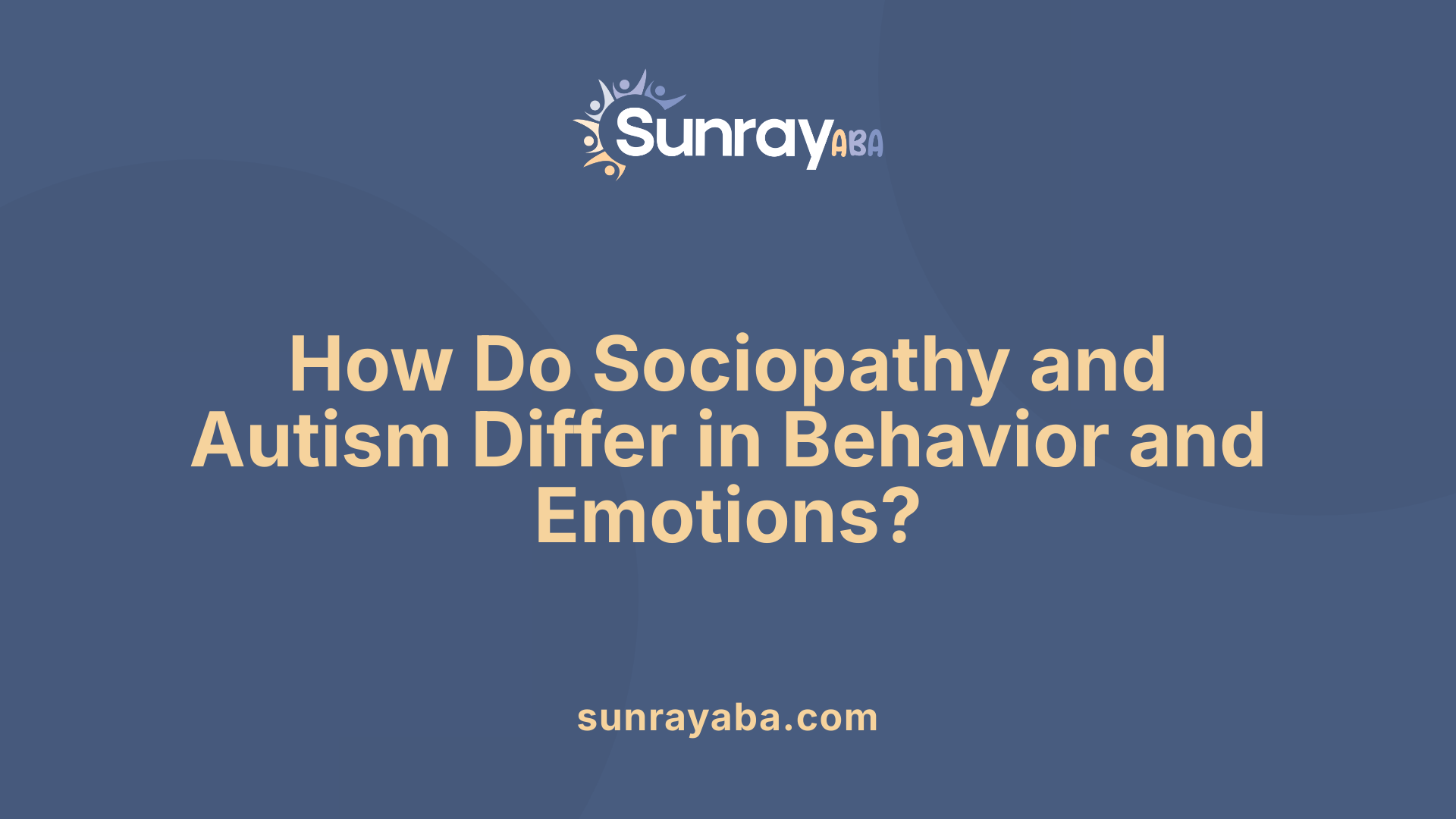
What are the main differences and similarities between sociopaths and individuals with autism?
Sociopathy, commonly associated with antisocial personality disorder (ASPD), manifests through traits like impulsivity, superficial charm, manipulative behaviors, and a significant lack of empathy. Individuals with sociopathy often engage in deceit, violate social norms, and show little remorse for their actions. These behaviors are typically driven by a desire for personal gain or to manipulate others.
On the other hand, autism spectrum disorder (ASD) is a neurodevelopmental condition characterized mainly by persistent challenges in social interaction, communication, and the presence of repetitive behaviors. People with autism generally have a genuine desire to connect socially but struggle to interpret social cues and respond appropriately. Despite difficulties in social settings, they usually possess intact or even heightened emotional empathy, though they may find it hard to express it outwardly.
While both conditions may appear to involve social difficulties, their roots and motivations differ greatly. Sociopaths tend to understand social rules but choose to manipulate or harm others for self-interest. Autism involves an inherent difficulty in comprehending social nuances due to neurological differences, not an intent to manipulate. Their behavioral overlaps can sometimes lead to confusion, but the underlying traits reveal distinct patterns of behavior.
What behavioral and emotional traits distinguish sociopaths from autistic individuals?
The behaviors and emotions of sociopaths and autistic individuals differ markedly.
Sociopaths (or individuals with ASPD) often display superficial charm and manipulate others with little regard for their feelings or rights. Their actions are impulsive, and they frequently engage in deceitful or harmful conduct, sometimes resorting to violence. They tend to understand social cues but use this knowledge strategically for personal advantage. Importantly, they lack genuine emotional empathy—they may mimic emotional responses but do not feel remorse or concern for others.
Autistic individuals, however, often face challenges in reading and responding to social cues and may appear distant or indifferent. Yet, many do feel empathy, especially affective empathy—responding emotionally to others' distress—though they struggle with cognitive empathy, which involves understanding others' perspectives. Their behaviors, such as engaging in routines or sensory sensitivities, are primarily driven by neurological differences rather than intentional manipulation.
While autistic behaviors can include frustration or aggression—often a response to sensory overload or communication difficulties—these are not aimed at hurting others but are forms of expression or coping.
The primary differences lie in the motivation behind behaviors: sociopaths often aim to manipulate or exploit others intentionally, with little emotional regard, whereas autistic individuals generally seek social connection but are limited by their condition. Autism involves genuine social difficulties rooted in neurodevelopmental factors, contrasting with the strategic and often callous behaviors observed in sociopathy.
Developmental Timing and Symptom Presentation

How can clinicians differentiate between sociopathy and autism during diagnosis?
Distinguishing between sociopathy (also known as antisocial personality disorder, ASPD) and autism spectrum disorder (ASD) hinges significantly on the onset age of symptoms and characteristic behaviors.
Autism generally manifests early in childhood, often before age three. Children with autism typically display persistent challenges with social interaction, communication, and exhibit repetitive behaviors or intense interests. Sensory sensitivities are also common. These developmental delays and social difficulties are evident in early developmental stages, and caregivers often report concerns during toddlerhood or preschool years.
In contrast, sociopathy—or ASPD—generally develops during adolescence or adulthood. Its hallmark features include manipulative behaviors, impulsivity, and a lack of remorse or empathy. Unlike autism, these behaviors often emerge after the age of 15 and are usually preceded by conduct disorder in childhood.
Clinicians assess the timing of symptom onset, behavioral patterns, and developmental history. For autism, social difficulties are often due to an inherent disability in interpreting social cues, despite a genuine desire to connect. Conversely, sociopathy involves behaviors aimed at self-interest or manipulation, with emotional indifference.
Further differentiating factors include the nature of empathy. Autistic individuals tend to have intact affective empathy—they can respond emotionally to others’ distress—but may struggle with cognitive empathy, making it hard to understand perspectives. People with sociopathy often show diminished emotional responsiveness overall, implying a different underlying emotional and cognitive profile.
Assessment tools include behavioral observations, structured interviews, and psychological testing. Neuroimaging can provide supporting evidence, although it is not typically necessary for diagnosis. The focus remains on identifying early developmental signs versus those that emerge later in life.
In summary, the timing of symptom emergence—early childhood for autism and adolescence or adulthood for sociopathy—along with the motivation behind behaviors and emotional responsiveness, are critical for accurate diagnosis.
More information:
Search queries such as "Onset age differentiation between autism and sociopathy," "diagnostic criteria," and "behavioral assessment methods" can provide deeper insights into the nuanced process clinicians use for accurate differentiation. Careful analysis of developmental history, symptom progression, and behavioral context remains essential for effective diagnosis and subsequent intervention.
Underlying Causes and Psychological Insights
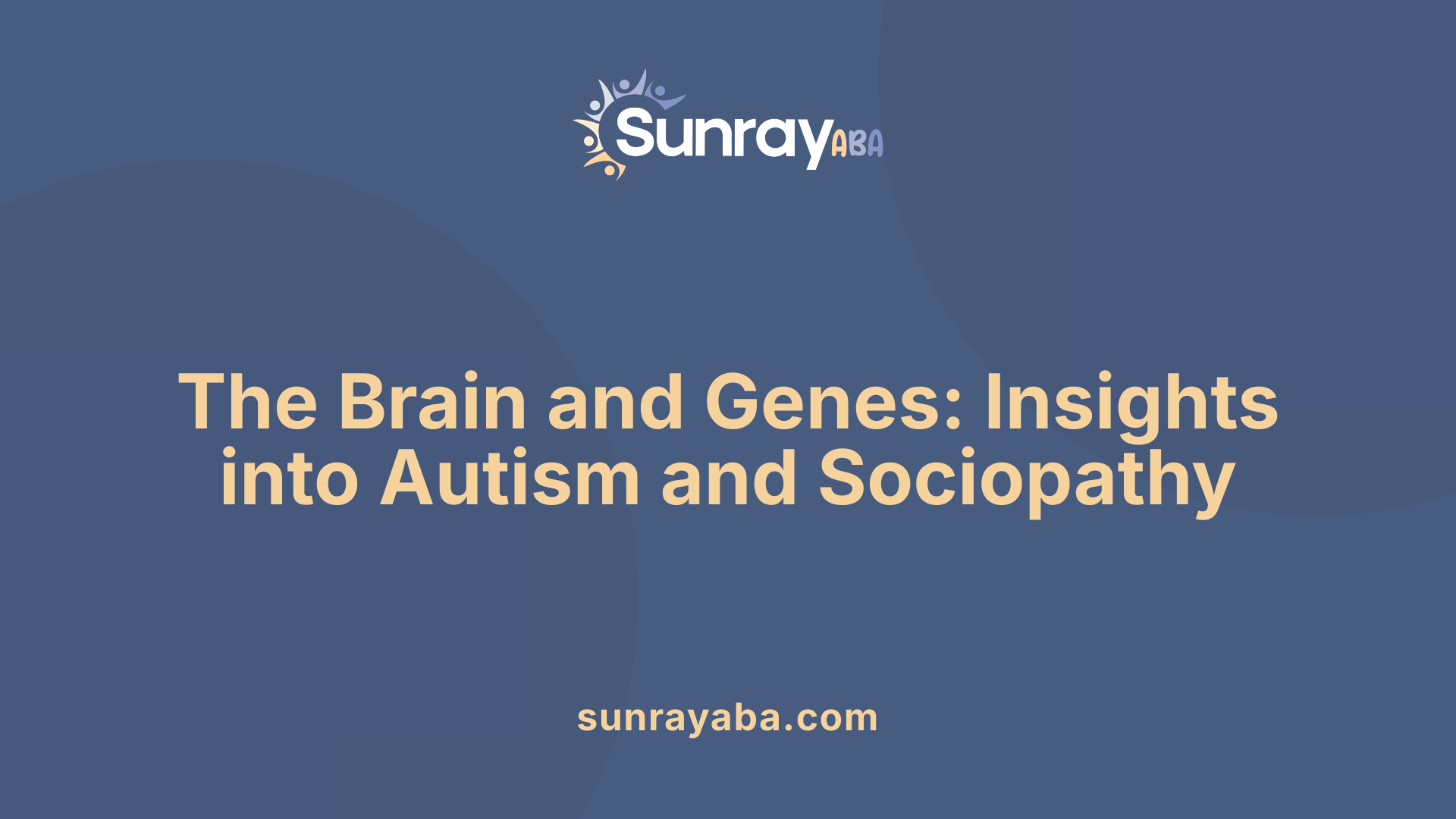
What scientific and clinical insights help in understanding psychopathy and autism?
Advances in neuroimaging and genetic research provide significant insights into the distinct yet occasionally overlapping biological underpinnings of autism and psychopathy. Neuroimaging studies reveal structural and functional differences in brain regions associated with social cognition, emotional processing, and moral reasoning.
In psychopathy, abnormalities are often observed in the amygdala, prefrontal cortex, and regions involved in emotional regulation, such as the right temporal pole and inferior frontal gyrus. These areas show reduced grey matter volume and atypical activity levels, correlating with deficits in affective empathy and moral judgment. Psychopaths often understand social rules intellectually but lack emotional engagement, making their social behavior manipulatory and callous.
Autism spectrum disorder, on the other hand, involves differences in neural connectivity impacting social communication and repetitive behaviors. Structural variations are frequently found in the precuneus, cerebellum, and superior temporal regions, which are implicated in social perspective-taking, sensory integration, and communication.
Distinct from psychopathy, autism primarily affects cognitive empathy—the mental capacity to understand others’ viewpoints—while affective empathy tends to be preserved or heightened. This means autistic individuals can emotionally respond to others’ distress but struggle with interpreting social cues and developing reciprocal relationships.
Overall, these brain differences highlight the contrasting mechanisms underlying affective versus cognitive empathy deficits. Evidence suggests psychopathy involves impaired emotional arousal and moral reasoning with relatively preserved social cognition, whereas autism involves challenges mainly in social understanding and communication despite often having strong emotional responses.
Ongoing research continues to refine our understanding of these neural pathways. Combining neuroimaging with genetic studies and behavioral assessments is vital for improving diagnostic accuracy and formulating targeted, personalized interventions that address the unique neurobiological profiles of each condition.
What behavioral and emotional traits distinguish sociopaths from autistic individuals?
Sociopaths, associated with antisocial personality disorder (ASPD), display shallow emotional responses, with diminished capacity for empathy and remorse. They often engage in manipulative, impulsive, and sometimes violent behaviors, driven by self-interest. Their understanding of social cues is often superficial, allowing them to exploit others while maintaining a veneer of charm and control.
In contrast, autistic individuals typically exhibit genuine emotional responses and can be highly empathetic, especially affective empathy—the ability to emotionally resonate with others’ feelings. However, they face significant difficulties in recognizing and interpreting social and emotional cues, which hampers reciprocal interactions.
Autistic behaviors include repetitive routines, sensory sensitivities, and a preference for sameness, stemming from neurodevelopmental differences rather than social manipulation. Their motivation to connect socially is genuine, but their communication challenges and perspective-taking difficulties create barriers.
The fundamental distinction lies in motivation and emotional engagement. Sociopaths deliberately manipulate others and are largely indifferent to their feelings, while autistic individuals’ social struggles result from intrinsic neurological differences, not deliberate cruelty or exploitation.
Understanding these differences enhances awareness and guides appropriate interventions that support social development and emotional understanding tailored to each diagnostic profile.
Emotional Processing and Social Behavior
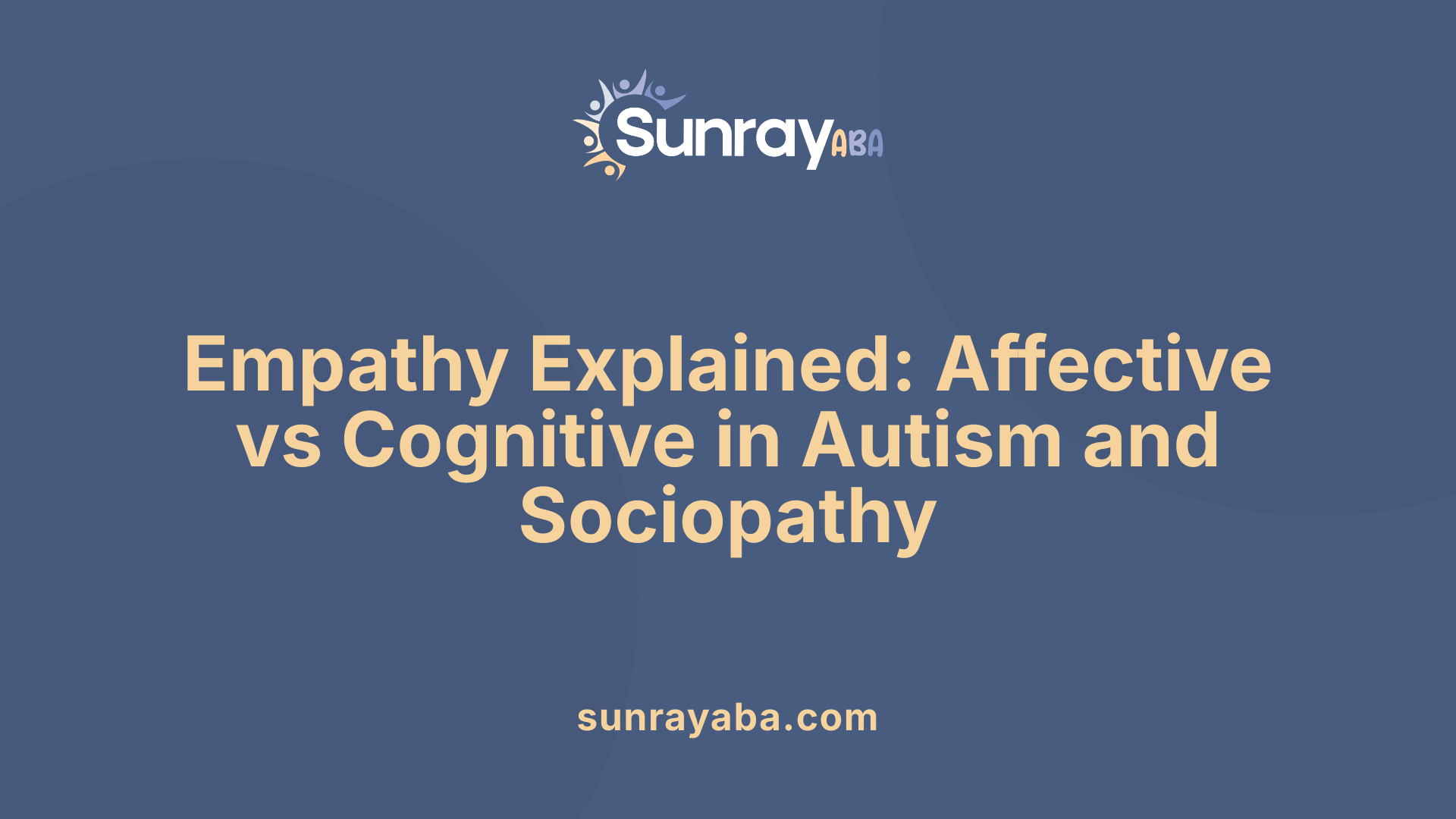
How do affective versus cognitive empathy manifest in autism and sociopathy?
In understanding the social behaviors of autism and sociopathy, it is crucial to differentiate between affective and cognitive empathy. Affective empathy refers to the capacity to physically feel and share another person’s emotional states. Cognitive empathy, on the other hand, involves understanding another's mental perspective or intentions.
Adults with psychopathy typically exhibit diminished affective empathy, meaning they do not emotionally resonate with others' distress. Despite this, they often retain cognitive empathy, enabling them to comprehend what others are thinking or feeling without emotionally responding. This combination can foster manipulative behaviors, as they can understand social cues without feeling remorse or guilt.
Conversely, autistic adults usually possess intact affective empathy. They can emotionally respond to others’ feelings, such as showing concern or distress. However, many experience deficits in cognitive empathy, which hampers their ability to interpret social cues accurately or adopt others’ viewpoints. This limitation repeatedly leads to social misunderstandings and difficulties in forming reciprocal relationships.
In children, these patterns are similar: autistic children often show reduced cognitive empathy but maintain affective empathy. They may genuinely care about others' feelings but struggle to understand social signals or predict social outcomes. In contrast, individuals with sociopathy predominantly lack affective empathy and display superficial understanding of others’ emotions, focusing instead on personal gain or manipulation.
Understanding this differentiation helps explain specific behavioral patterns and emotional responses seen across these conditions. Autistic individuals’ frustrations often stem from their difficulty with social cues, sensory overload, or communication challenges. Meanwhile, those with sociopathy may demonstrate anger or hostility rooted in impulsivity, frustration from perceived obstruction, or a lack of concern for others’ feelings.
Implications for Treatment and Education
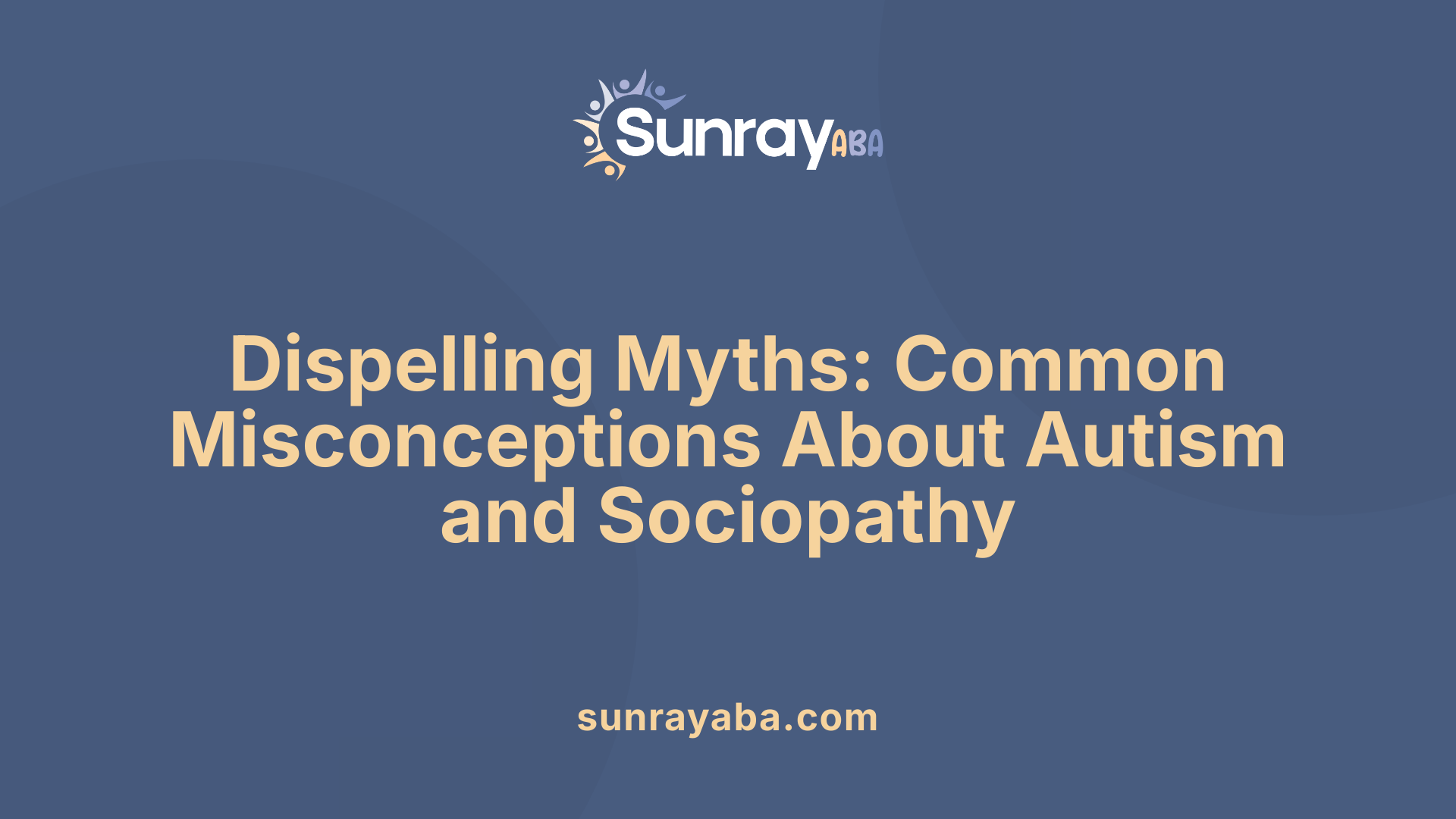
What are some common misconceptions about sociopathy and autism?
A widespread misunderstanding is that autistic individuals are intentionally antisocial or lack empathy. In truth, many people on the autism spectrum experience empathy but face challenges interpreting social cues and expressing themselves appropriately. This often leads others to perceive them as aloof or indifferent, which is not accurate.
Conversely, sociopaths or individuals with antisocial personality disorder (ASPD) are frequently misjudged as merely socially awkward or mean-spirited. In reality, their behavior is typically intentional, characterized by manipulation, deceit, and a lack of remorse. They often display superficial charm and impulsive tendencies, primarily acting to satisfy their own interests.
Understanding these distinctions helps in dispelling stereotypes. Autism is primarily a neurodevelopmental condition with onset in early childhood, involving persistent social and communication difficulties. On the other hand, ASPD is a pattern of disregard for others' rights, usually diagnosed in adulthood after a history of conduct disorder.
While both conditions can influence social behaviors, their roots differ significantly. Autism stems from developmental factors affecting brain growth, while sociopathy involves complex interactions between biological predispositions and environmental influences.
Recognizing and educating others about these differences is essential to foster empathy, provide appropriate support, and prevent stigmatization. Such understanding promotes better clinical approaches, tailored treatments, and enhanced social acceptance.
The Role of Clinical Assessment and Support
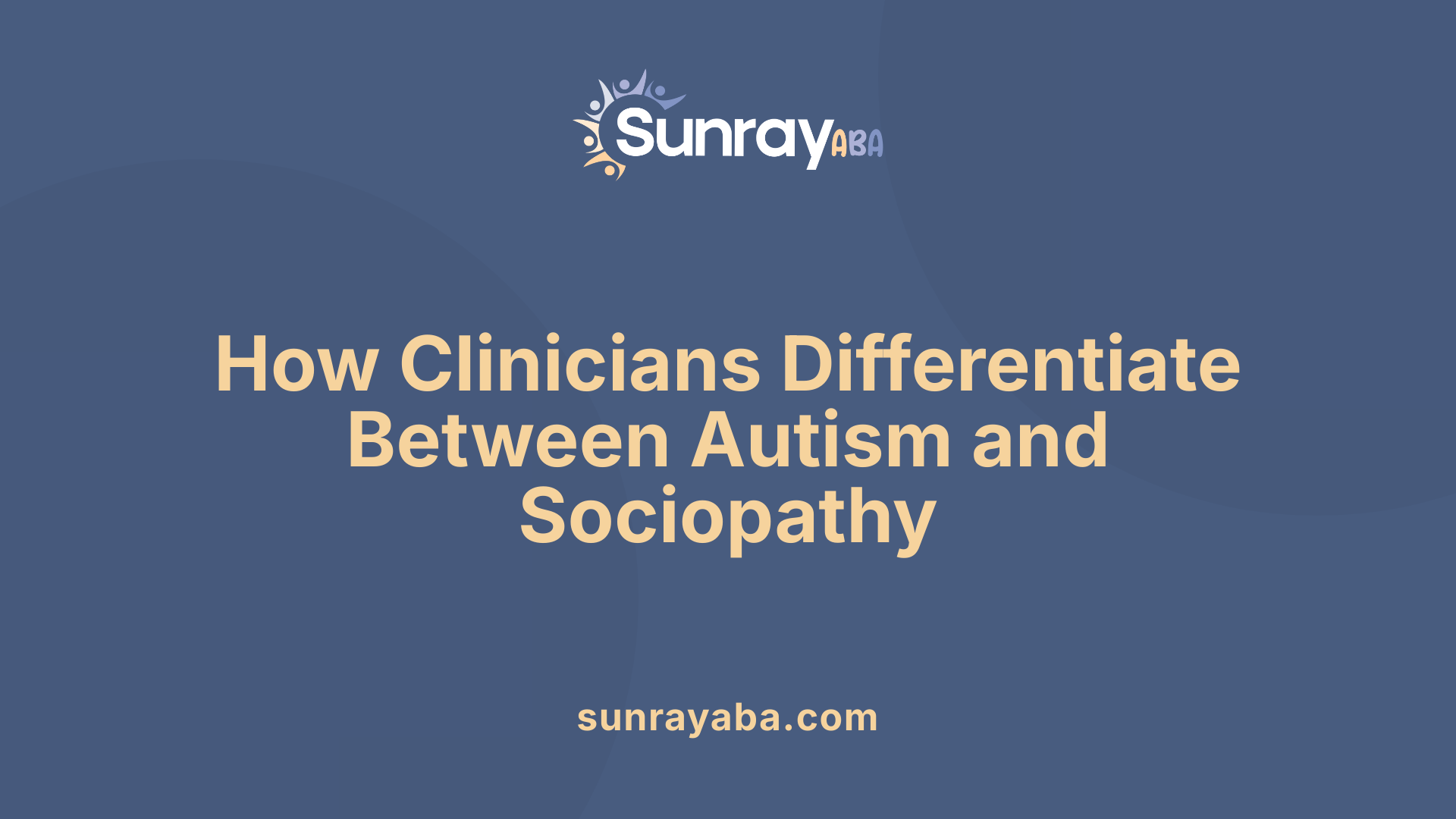
How can clinicians differentiate between sociopathy and autism during diagnosis?
Differentiating between sociopathy (also called antisocial personality disorder, ASPD) and autism spectrum disorder (ASD) is a nuanced process that relies greatly on comprehensive clinical assessment. Since both conditions can involve social difficulties, proper evaluation is crucial for accurate diagnosis and subsequent support.
Clinicians begin by gathering detailed developmental history, with particular attention to the onset of symptoms. Autism symptoms are typically present early in childhood, often evident from developmental delays in communication, social interaction, and repetitive behaviors. For example, children with autism may struggle to initiate social interactions, have trouble reading social cues, and display specific interests or routines. They may also be sensitive to sensory stimuli. In contrast, sociopathy usually manifests in adolescence or adulthood, characterized by manipulative, impulsive, and often aggressive behaviors, with little regard for others' feelings.
Behavioral patterns provide essential clues. Autism involves genuine difficulty in understanding and responding to social and emotional cues—yet affective empathy (feeling others' emotions) is generally intact. These individuals often want to connect but cannot interpret social signals effectively. On the other hand, people with ASPD tend to be indifferent to others’ emotions, pursuing their goals with little remorse or regard for social rules, often manipulating or exploiting others.
Assessment tools include structured behavioral observations, psychological testing, and neuroimaging when appropriate. These methods help identify patterns consistent with either condition. For example, early signs of communication delays and repetitive behaviors support an autism diagnosis, while conduct disorder in childhood followed by antisocial behaviors in adulthood point toward sociopathy.
Understanding the motivation behind behaviors also aids differentiation. Autism-related behaviors stem from communication and sensory processing differences, whereas ASPD behaviors often revolve around self-interest, manipulation, and a disregard for societal norms.
In sum, clinicians must analyze the timing and nature of symptoms, emotional responses, and developmental history. Proper evaluation involves integrating observational data, psychological assessments, and sometimes neuroimaging. Such a comprehensive approach ensures accurate diagnosis, which is essential for tailoring effective support and intervention strategies.
Summary and Final Thoughts

What are the main similarities and differences between autism and sociopathy?
Autism spectrum disorder (ASD) and sociopathy, also known as antisocial personality disorder (ASPD), are distinct conditions but can sometimes present overlapping behaviors, making understanding the differences essential. Autism is a neurodevelopmental condition that appears early in childhood, characterized by difficulties in social interaction, communication challenges, repetitive behaviors, and sensory sensitivities. Individuals with autism often genuinely desire social connection but struggle with reading social cues and expressing emotions.
In contrast, sociopathy involves persistent patterns of disregard for others’ rights, manipulative behaviors, impulsivity, and superficial charm. People with sociopathy may lack empathy and remorse, often acting in self-interest with little regard for social norms. Their behaviors are more deliberate, often aimed at personal gain, sometimes associated with anger or violence.
How do deficits in empathy manifest in these conditions?
A critical difference lies in empathy. Adults with autism tend to have intact affective empathy—they can respond appropriately to others’ emotions—but may have impaired cognitive empathy, which is the ability to understand others’ perspectives. Children and adults with autism often struggle with interpreting social cues, which affects their social interactions.
On the other hand, individuals with psychopathy or sociopathy typically display diminished affective empathy but may retain cognitive empathy to some extent. This means they understand what others feel but do not necessarily share or respond emotionally to those feelings. This lack of emotional connection can lead to manipulative or harmful behaviors.
How does development influence these conditions?
Autism begins early in childhood, with noticeable developmental delays and impairments in social and communication skills. It often involves repetitive behaviors and sensory sensitivities.
Sociopathy, however, generally develops later, often diagnosed after age 18, although it may be preceded by conduct disorder in childhood. Unlike autism, the core features include a disregard for others' rights, impulsivity, and manipulative tendencies. The motivations behind their social behaviors differ markedly from those in autism.
Can co-occurrence happen?
Research indicates that some individuals may exhibit traits of both conditions, especially in forensic settings. For example, some with autism may show increased callous-unemotional traits, and cases of comorbidity, while documented, are complex and challenging to diagnose accurately due to overlapping or confounding features.
How are these conditions diagnosed and treated?
Diagnosis involves thorough assessments, including interviews, behavioral observations, psychological testing, and comprehensive history reviews. Proper diagnosis is essential to differentiate autism from antisocial behaviors, as treatment strategies differ significantly.
Supporting individuals with autism typically involves behavioral therapies, social skills training, and creating supportive environments that accommodate sensory sensitivities and communication needs. Those with sociopathy may require behavioral management, therapy focusing on impulse control, and social rehabilitation—although treatment outcomes vary.
Why is it important to understand these conditions?
Misconceptions are widespread. A common stereotyping is that autistic individuals are intentionally anti-social or lacking empathy, which is misleading. They often want social connection but face neurological barriers. Similarly, sociopaths are often misunderstood as simply mean or socially awkward, but their behaviors stem from different neurobiological and environmental origins.
Education and awareness help combat stereotypes, fostering understanding and acceptance. Recognizing that autism involves neurodevelopmental differences leading to social and communication challenges, while sociopathy involves manipulative behaviors with little remorse, is crucial.
How can social perception be improved?
Promoting public awareness through education campaigns, accurate media portrayals, and inclusive policies fosters a more accepting society. Emphasizing the distinct nature of these conditions reduces stigma and encourages appropriate interventions.
Investing in research and training for clinicians enhances diagnosis and supports individualized treatment plans, which are vital for improving quality of life.
To sum up
Both autism and sociopathy fundamentally differ in their origins, development, and social impact. Autism involves a genuine desire to connect but faces neurological barriers, whereas sociopathy involves deliberate manipulation and lack of remorse. Understanding these differences promotes compassion, reduces stereotypes, and underpins efforts toward effective support and societal inclusion.
| Aspect | Autism Spectrum Disorder | Sociopathy / ASPD | Explanation |
|---|---|---|---|
| Onset | Early childhood | After age 18 (often preceded by conduct disorder) | Developmental versus adult onset |
| Core traits | Social communication challenges, repetitive behaviors | Disregard for others’ rights, manipulation, impulsivity | Main behavioral differences |
| Empathy | Intact affective, impaired cognitive | Lack of affective, possible awareness of what others feel | Emotional response differences |
| Motivation | Desire to connect socially | Self-interest, manipulation | Underlying driving forces |
| Treatment | Behavioral therapies, social skills | Behavioral management, therapy | Approaches depend on diagnosis |
| Stigma | Often misunderstood as mean or aloof | Associated with dangerousness or criminality | Public perceptions |
| Overlap Potential | Traits like callousness can appear | Some autism traits may be misinterpreted | Complex cases requiring careful evaluation |
Understanding these distinctions is vital for effective intervention, reducing stigma, and fostering a society that values the differences of each individual.
Promoting Awareness and Inclusive Understanding
Distinguishing between sociopathy and autism is essential not only for accurate diagnosis and effective treatment but also for fostering societal acceptance and support. Misconceptions often lead to misunderstandings—autistic individuals are not intentionally antisocial, nor are sociopaths merely misunderstood or mean. Advances in neuroimaging and behavioral science continue to shed light on the different neural pathways involved, emphasizing the importance of a nuanced approach to each condition. Education and awareness campaigns play a critical role in dispelling myths, reducing stigma, and creating inclusive environments where individuals with either condition can thrive through tailored interventions and societal acceptance.
References
- The relationship between psychopathy and autism: a systematic ...
- Sociopath vs. Autistic Behavior: Understanding the Differences
- Autism vs. Antisocial Personality: The Controversy Continues
- Antisocial Personality Disorder vs Autism
- Sociopath vs. Autistic Behavior: Understanding the Differences
- The relationship between psychopathy and autism: a systematic ...
- Sociopath vs. Autism: Differentiating Traits - ABATherapistJobs.com
- Dissecting empathy: high levels of psychopathic and autistic traits ...
- The relationship between psychopathy and autism: a systematic ...